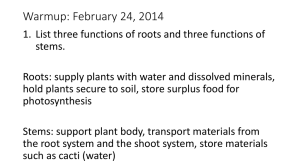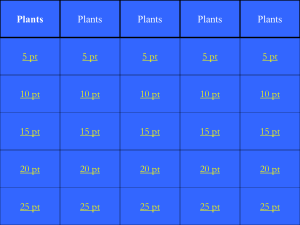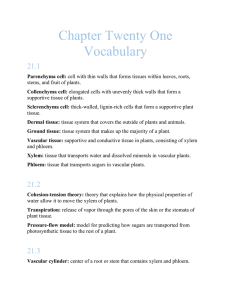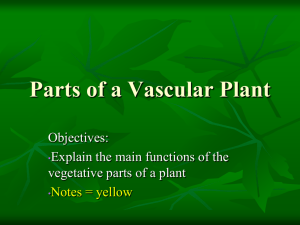23 Roots, Stems and Leaves Page 578 Chapter
advertisement
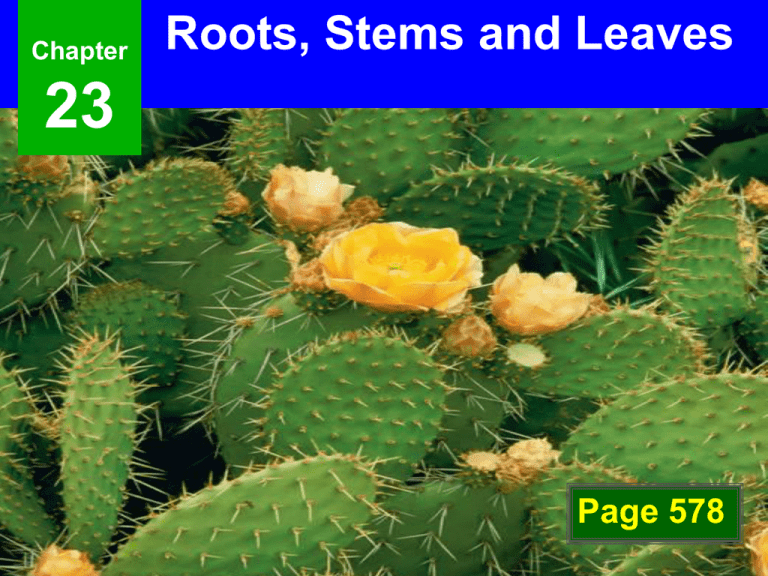
Chapter Roots, Stems and Leaves 23 Page 578 23–1 Specialized Tissues in Plants 23-1 Introduction to Plants Seed Plant Structure The three principal organs of seed plants are roots, stems, and leaves. These organs perform functions such as the transport of nutrients, protection, and coordination of plant activities. 23-1 Introduction to Plants Roots: • absorb water and dissolved nutrients. • anchor plants in the ground. • protect the plant from harmful soil bacteria and fungi. Seed Plant Structure 23-1 Introduction to Plants Seed Plant Structure Stems: • a support system for the plant body. • a transport system that carries nutrients. • a defense system that protects the plant against predators and disease. 23-1 Introduction to Plants Seed Plant Structure Leaves: • are a plant’s main photosynthetic systems. • increase the amount of sunlight plants absorb. Adjustable pores conserve water and let oxygen and carbon dioxide enter leave. 23-1 Introduction to Plants Plant Tissue Systems Plants consist of three main tissue systems: •dermal tissue - outer •vascular tissue - transport •ground tissue - structure 23-1 Introduction to Plants Seed Plant Structure Leaf Stem Root 23-1 Introduction to Plants Dermal Tissue Dermal tissue is the outer covering of a plant and consists of epidermal cells. Epidermal cells make up dermal tissue. Epidermal cells are covered with a thick waxy layer, called the cuticle, which protects the plant against water loss and injury. 23-1 Introduction to Plants Dermal Tissue Some epidermal cells have projections called trichomes, that help protect the leaf and also give it a fuzzy appearance. In roots, dermal tissue includes root hair cells that provide a large amount of surface area and aid in water absorption. On the underside of leaves, dermal tissue contains guard cells, which regulate water loss and gas exchange. 23-1 Introduction to Plants Vascular Tissue Vascular tissue forms a transport system that contains several types of specialized cells. •Xylem consists of tracheids and vessel elements. •Phloem consists of sieve tube elements and companion cells. 23-1 Introduction to Plants Vascular Tissue Cross Section of a Stem Tracheid Vessel element Xylem Companion cell Sieve tube element Phloem 23-1 Introduction to Plants Vascular Tissue Xylem All seed plants have tracheids. Tracheids are long, narrow cells that are impermeable to water, but they have holes that connect cells. Tracheid Vessel element 23-1 Introduction to Plants Vascular Tissue Angiosperms also have vessel elements. Vessel elements form a continuous tube through which water can move. Tracheid Vessel element 23-1 Introduction to Plants Vascular Tissue Phloem Phloem contains sieve tube elements and companion cells. Companion cell Sieve tube Sieve tube element elements are phloem cells joined end-to-end to form sieve tubes. 23-1 Introduction to Plants Vascular Tissue The end walls of sieve tube elements have many small Companion cell holes that Sieve tube element sugars and other foods can move through. 23-1 Introduction to Plants Vascular Tissue Companion cells are phloem cells that surround sieve tube elements. Companion cells support sieve tubes and aid in the movement of substances in and out of the phloem. Companion cell Sieve tube element 23-1 Introduction to Plants Ground Tissue Between dermal and vascular tissues are ground tissues. Three kinds of ground tissue: • Parenchyma- thin walls and large central vacuoles - storage • Collenchyma- strong, flexible cell walls that help support larger plants • Sclerenchyma- extremely thick, rigid cell walls = tough and strong 23-1 Introduction to Plants Ground Tissue 23-1 Introduction to Plants Growth & Meristematic Tissue In most plants, new cells are produced at the tips of the roots and stems. These cells are produced in meristems. Meristematic tissue is the only plant tissue that produces new cells by mitosis. A meristem is a cluster of tissue that is responsible for continuing growth throughout a plant's lifetime. 23-1 Introduction to Plants Growth & Meristematic Tissue Near the tip of each growing stem and root is an apical meristem. An apical meristem is at the tip of a growing stem or root. 23–2 Roots 23-2 Roots Types of Roots In some plants, the primary root grows long and thick and is called a taproot. Fibrous roots branch to such an extent that no single root grows larger than the rest. 23-2 Roots Types of Roots Tap Roots Fibrous Roots 23-2 Roots Types of Roots A carrot is an example of a taproot. Tap Roots Fibrous Roots 23-2 Roots Types of Roots Fibrous roots are found in grasses. Tap Roots Fibrous Roots 23-2 Roots Root Structure and Growth • Roots contain cells from dermal, vascular, and ground tissue. 23-2 Roots Root Structure and Growth A mature root has an outside layer, the epidermis, and a central cylinder of vascular tissue. Between these two tissues lies a large area of ground tissue. The root system plays a key role in water and mineral transport. 23-2 Roots Root Structure and Growth The root’s surface is covered with cellular projections called root hairs. Root hairs provide a large surface area through which water can enter the plant. Root hairs 23-2 Roots Root Structure and Growth Epidermis The epidermis (including root hairs) protects the root and absorbs water. 23-2 Roots Inside the epidermis is a layer of ground tissue called the cortex. Root Structure and Growth Ground tissue (cortex) 23-2 Roots Root Structure and Growth The cortex extends to another layer of cells, the endodermis. The endodermis completely encloses the vascular cylinder. Endodermis 23-2 Roots The vascular cylinder is the central region of a root that includes the xylem and phloem. Root Structure and Growth Vascular cylinder Phloem Xylem 23-2 Roots Root Structure and Growth Roots grow in length as their apical meristem produces new cells near the root tip. Apical meristem 23-2 Roots Root Structure and Growth These new cells are covered by the root cap that protects the root as it forces its way through Apical meristem the soil. Root cap 23-2 Roots Root Functions The most important nutrients plants need include: •nitrogen •phosphorus •potassium •magnesium •calcium 23-2 Roots Root Functions Active Transport of Minerals • The cell membranes of root epidermal cells contain active transport proteins. 23-2 Roots Root Functions •Transport proteins use ATP to pump mineral ions from the soil into the plant. Root hairs 23-2 Roots Root Functions The high concentration of mineral ions in the plant cells causes water molecules to move into the plant by osmosis. 23-2 Roots Root Functions Movement Into the Vascular Cylinder • Osmosis and active transport move water and minerals from the root epidermis into the cortex. • The water and dissolved minerals pass the inner boundary of the cortex and enter the endodermis. 23-2 Roots Root Functions The endodermis is composed of many individual cells. Water moves into the vascular cylinder by osmosis. Endodermis 23-2 Roots Root Functions Each cell is surrounded on four sides by a waterproof strip called a Casparian strip. The Casparian strip prevents the backflow of water out of the vascular cylinder into the root cortex. Casparian strip Casparian strip 23-2 Roots Root Functions As more water moves from the cortex into the vascular cylinder, more water in the xylem is forced upward through the root into the stem. Root pressure pushes water through the vascular system of the entire plant. 23–3 Stems 23-3 Stems Stem Structure and Function Stem functions: • they produce leaves, branches and flowers • they hold leaves up to the sunlight • they transport substances between roots and leaves • Can do photosynthesis 23-3 Stems Stem Structure and Function Stems make up an essential part of the water and mineral transport systems of the plant. Xylem and phloem form continuous tubes from the roots through the stems to the leaves. This allows water and nutrients to be carried throughout the plant. 23-3 Stems Stem Structure and Function Stems are surrounded by a layer of epidermal cells that have thick cell walls and a waxy protective coating. 23-3 Stems Stem Structure and Function • Leaves attach to the stem at structures called nodes. Bud • The regions of stem between the nodes are internodes. Internode Node • Small buds are found where leaves attach to nodes. Node 23-3 Stems Stem Structure and Function Buds contain undeveloped tissue that can produce new stems and leaves. In larger plants, stems develop woody tissue that helps support leaves and flowers. Bud 23-3 Stems Monocot and Dicot Stems Monocot Stems • Monocot stems have a distinct epidermis, which encloses vascular bundles. • Each vascular Epidermis Vascular bundles Ground tissue bundle contains xylem and phloem tissue. Monocot 23-3 Stems Monocot and Dicot Stems • Monocot Stems • Vascular Epidermis Vascular bundles bundles are scattered throughout the ground tissue. • Ground tissue consists mainly of parenchyma cells. Ground tissue Monocot 23-3 Stems Monocot and Dicot Stems Dicot Stems • Dicot stems have vascular bundles arranged in a ringlike pattern. • The parenchyma cells inside the vascular tissue are known as pith. Vascular bundles Epidermis Cortex Pith Dicot 23-3 Stems Monocot and Dicot Stems • Dicot Stems • The parenchyma Vascular bundles Epidermis cells outside of the vascular tissue form the cortex of the stem. Cortex Pith Dicot 23-3 Stems • All seed plants Primary Growth of Stems undergo Primary growth primary growth, which is an increase in length. Apical meristem Primary growth • For the entire life of the plant, new cells are produced at the tips of roots and shoots. Leaf scar Year 1 Year 2 Year 3 23-3 Stems Primary Growth of Stems Apical meristem Primary growth of stems is produced by cell divisions in the apical meristem. It takes place in all seed plants. 23-3 Stems Secondary Growth of Stems Stems increase in width due to secondary growth. Secondary growth produces wood. Thin tree ring = slow growth, often due to drought. 23-3 Stems Secondary Growth of Stems Formation of the Vascular Cambium • Once secondary growth begins, the vascular cambium appears as a thin layer between the xylem and phloem of each vascular bundle. Vascular cambium 23-3 Stems Secondary Growth of Stems The vascular cambium divides to produce xylem cells toward the center of the stem and phloem cells toward the outside. Secondary phloem Secondary xylem 23-3 Stems Secondary Growth of Stems Wood Formation of Wood • Wood is actually layers of xylem. These cells build up year after year. Bark 23-3 Stems Secondary Growth of Stems As woody stems grow thicker, older xylem cells near the center of the stem no longer conduct water. This is called heartwood. Heartwood supports the tree. Xylem: Heartwood 23-3 Stems Secondary Growth of Stems Heartwood is surrounded by sapwood. Sapwood is active in water and mineral transport. Xylem: Sapwood 23-3 Stems Secondary Growth of Stems Formation of Bark • On most trees, bark includes all of the tissues outside the vascular cambium — phloem, the cork cambium and cork. Bark 23-3 Stems Secondary Growth of Stems The vascular cambium produces new xylem and phloem, which increase the width of the stem. Vascular cambium 23-3 Stems Secondary Growth of Stems The phloem transports sugars produced by photosynthesis. Phloem 23-3 Stems Secondary Growth of Stems Cork cambium The cork cambium produces a protective layer of cork. 23-3 Stems Secondary Growth of Stems Cork The cork contains old, nonfunctioning phloem that protects the tree. 23–4 Leaves 23-4 Leaves Leaf Structure The structure of a leaf is optimized for absorbing light and carrying out photosynthesis. 23-4 Leaves Leaf Structure To collect sunlight, most leaves have thin, flattened sections called blades. Blade Simple leaf Leaflet Petiole Bud Stem Compound leaf 23-4 Leaves Leaf Structure The blade is attached to the stem by a thin stalk called a petiole. Blade Simple leaf Leaflet Petiole Bud Stem Compound leaf 23-4 Leaves Leaf Structure Simple leaves have only one blade and one petiole. Blade Simple leaf Leaflet Petiole Bud Stem Compound leaf 23-4 Leaves Leaf Structure Compound leaves have several blades, or leaflets, that are joined together and to the stem by several petioles. Blade Simple leaf Leaflet Petiole Bud Stem Compound leaf 23-4 Leaves Leaf Structure Leaves are covered on the top and bottom by epidermis. Epidermis Epidermis 23-4 Leaves Leaf Structure The epidermis of many leaves is covered by the cuticle. Cuticle Epidermis Epidermis 23-4 Leaves Leaf Structure The cuticle and epidermal cells form a waterproof barrier that protects tissues inside the leaf and limits the loss of water through evaporation. The veins of leaves are connected directly to the vascular tissues of stems. 23-4 Leaves Leaf Structure In leaves, xylem and phloem tissues are gathered together into bundles that run from the stem into the petiole. In the leaf blade, the vascular bundles are surrounded by parenchyma and sclerenchyma cells. 23-4 Leaves Leaf Structure All these tissues form the veins of a leaf. Xylem Phloem Vein 23-4 Leaves Leaf Functions • Most leaves consist of a specialized ground tissue known as mesophyll. Palisade mesophyll Spongy mesophyll 23-4 Leaves Leaf Functions The layer of mesophyll cells found directly under the epidermis is called the palisade mesophyll. These closely-packed cells absorb light that enters the leaf. Palisade mesophyll 23-4 Leaves Leaf Functions Beneath the palisade mesophyll is the spongy mesophyll, a loose tissue with many air spaces between its cells. Spongy mesophyll 23-4 Leaves Leaf Functions The air spaces connect with the exterior through stomata. Stomata are openings in the underside of the leaf that allow carbon dioxide and oxygen to diffuse in and out. Stoma 23-4 Leaves Each stoma consists of two guard cells that control the opening and closing of stomata by responding to changes in water pressure. Leaf Functions Guard cells 23-4 Leaves Transpiration is the loss of water through leaves. Transpiration pulls water from the roots through the vascular tissues and out the leaves. Leaf Functions 23-4 Leaves Leaf Functions When water pressure within guard cells is high, the stoma open. Stoma are open in daytime, when photo -synthesis is active. 23-4 Leaves Leaf Functions When water pressure within guard cells decreases, the stoma closes. Stomata are closed at night, to prevent water loss. 23–5 Transport in Plants 23-5 Transport in Plants Water Pressure • Xylem tissue forms a continuous set of tubes that runs from the roots through stems and out into the spongy mesophyll of leaves. • Active transport and root pressure cause water to move from soil into plant roots. • Capillary action and transpiration also are needed to transport water and minerals. 23-5 Transport in Plants Water Pressure The combination of root pressure, capillary action, and transpiration provides enough force to move water through the xylem tissue of even the tallest plant. 23-5 Transport in Plants Water Pressure Cohesion is the attraction of water molecules to each other. Adhesion is the attraction between unlike molecules. 23-5 Transport in Plants The tendency of water to rise in a thin tube is called capillary action. Water is attracted to the walls of the tube, and water molecules are attracted to one another. Water Pressure 23-5 Transport in Plants Capillary action causes water to move much higher in a narrow tube than in a wide tube. Water Pressure 23-5 Transport in Plants Water Pressure Tracheids and vessel elements form hollow connected tubes in a plant. Capillary action in xylem causes water to rise well above the level of the ground. 23-5 Transport in Plants • When water is lost through transpiration, osmotic pressure moves water out of the vascular tissue of the leaf. Water Pressure 23-5 Transport in Plants The movement of water out of the leaf “pulls” water upward through the vascular system all the way from the roots. This process is known as transpirational pull. Water Pressure 23-5 Transport in Plants Water Pressure Controlling Transpiration • The water content of the leaf is kept relatively constant. • When there is a lot of water, water pressure in the guard cells is increased and the stomata open. • Excess water is lost through open stomata by transpiration. 23-5 Transport in Plants Nutrient Transport • Many plants pump sugars into their fruits. • In cold climates, plants pump food into their roots for winter storage. • This stored food must be moved back into the trunk and branches of the plant before growth begins again in the spring. 23-5 Transport in Plants Nutrient Transpo Movement from Source to Sink • A process of phloem transport moves sugars through a plant from a source to a sink. • A source is any cell in which sugars are produced by photosynthesis. • A sink is any cell where the sugars are used or stored. 23-5 Transport in Plants Nutrient Transport The pressure-flow hypothesis explains how phloem transport takes place. 23-5 Transport in Plants Nutrient Transport Pressure-Flow Hypothesis Sugars produced during photosynthesis are pumped into the phloem (source). Movement of water Movement of sugar Phloem Xylem Sugar molecules Source cell 23-5 Transport in Plants Nutrient Transport Phloem Xylem Pressure-Flow Hypothesis As sugar concentrations increase in the phloem, water from the xylem moves in by osmosis. Movement of water Movement of sugar Sugar molecules Source cell 23-5 Transport in Plants Nutrient Transport Pressure-Flow Hypothesis This movement causes an increase in pressure at that point, forcing nutrient-rich fluid to move through the phloem from nutrientproducing regions …. Movement of water Movement of sugar Phloem Xylem Sugar molecules Source cell 23-5 Transport in Plants Nutrient Transport Pressure-Flow Hypothesis Movement of water …. toward a region that uses these nutrients (sink). Movement of sugar Sink cell Phloem Xylem 23-5 Transport in Plants Nutrient Transport Pressure-Flow Hypothesis If part of a plant actively absorbs nutrients from the phloem, osmosis causes water to follow. This decreases pressure and causes a movement of fluid in the phloem Sink cell toward the sink. Movement of water Movement of sugar Phloem Xylem



